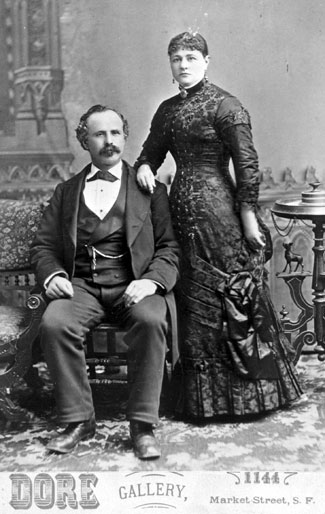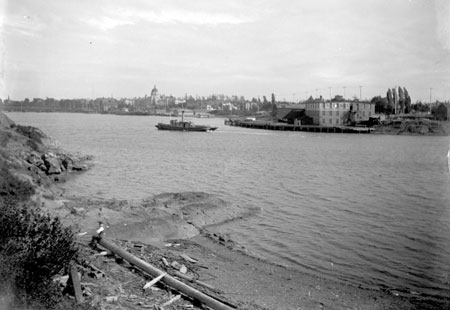Nov
5
Part One
By Ted Ross
|
|
| Image I-63137 courtesy of the Royal BC Museum, BC Archives |
Laurel Point is a peninsula jutting into Victoria harbour. Positioned near the entrance to the Inner Harbour, it was used by First Nations people for potlatch ceremonies hundreds of years ago. Today it is home to the Inn at Laurel Point, with its famous Erickson Wing, a series of graded, silver-blue balconies attached to spacious rooms overlooking the harbour.
People born before 1964 still remember the Bapco Paint factory which stood at the point until the early 1970s. It had been established, along with a soap-works, by William Pendray in 1908, when he moved the works from their earlier location on Humboldt Street, where the Empress Hotel was being constructed. Mr. Pendray had acquired the property on Laurel Point late in the 1890s, after a fire at that location in 1894.
But, what is the story of that fire, and the occupants of the point in the earlier days?
Once upon a time, music flowed at Laurel Point. On the rocky peninsula, high above the Inner Harbour, stood the palatial home of Jacob Sehl. To the west, the Sehl Furniture factory was closer to the harbour waters, its wharf on the point's west shore. The factory was three storeys and built of brick. Here Sehl produced fine furniture from Vancouver Island maple, built by twelve local craftsmen. He did a huge business in Victoria and on Vancouver Island, with a two-storey retail store on the corner of Government and Broughton Streets. The Laurel Point factory, with its wharf for ocean-going trade, was built in 1885 when business outgrew the Government Street location. T.W. Paterson writing in the Cowichan Valley Citizen relates, "Thus it was that the industrialist moved, lock, stock and maple, to Laurel Point (until this time virtually untouched by progress) where he constructed a large brick factory and a palatial residence known as one of the finest and largest in Victoria, both in the beauty of is outside appearance and in the elegance and completeness of its furnishings."
"With its terraced gardens, balconies and lookout tower, or cupola, the Sehl home became a familiar landmark to those entering and leaving Victoria Harbour. Designed by C.E. Apponyl, a noted architect of the day, the manor was described as being unique and a costly residence."
But who was this man, Jacob Sehl? In the report of his death in the Daily Colonist, June 16, 1904,we read:
 |
| Image A-02455 courtesy of the Royal BC Museum, BC Archives |
"(Jacob Sehl) was born at Ediger, near Coblentz, Germany on November 30, 1833. When the news of the gold discoveries on the Pacific slope reached Europe, he, in company with his brother, Frank, embarked on a sailing vessel, via the Horn, and reached here in the spring of 1858. The brothers visited Cariboo, the scene of the gold excitement, and for a time engaged in mining. Returning to Victoria, Jacob Sehl spent some further time mining at Sooke and on Leech River.
"In 1860 he started in the furniture business in a small way. Industrious, a good business man, and of an enterprising character, the venture proved profitable and speedily grew to such dimensions that larger premises were required. So in 1885 a large brick factory was constructed at what became known as 'Sehl's Point', James Bay, just where the harbor is narrowest, opposite the Indian reserve. He erected also, on a beautiful site near the factory, one of the most palatial residences in the city..."
When Jacob Sehl arrived from Germany, he brought with him more than a lust for gold. He also brought his love of music, especially choral music, which had been part of his life in Germany. In 1861 he, his wife Elizabeth, and brother Frank were involved in organizing the singing club, Germania Sing Verein, in Victoria.
The club gave many popular concerts. By January of 1866 Germania had grown so prosperous, and had become such a part of the community, that it moved into its own quarters. The soiree given by the club that spring took place in their new Alhambra Hall. The German singers were always successful in their social entertainments. Jacob Sehl was president of the club in 1866. It was said, "In the Jacob Sehl home, there was always much music."
It was an active club. There were soirees and dances, concerts, and picnics in summer. Usually the club gave a party New Year's Eve. May 1868 saw the club celebrate the Queen's birthday, with dancing until daylight. In February, 1869 Washington's birthday was reason for a soiree given at Alhambra.
By this time other than German citizens were in this music-making club. Music knows no social barriers. The Welsh, English, Scots, French and US citizens were singing night after night with the Germans. Music had been firmly established in Victoria.
The Sehls lived in a large house on Kane (Broughton) Street for several years. There they raised a family of two sons and two daughters. Jacob sang in the St. Andrew's Cathedral choir. He worked hard at the furniture business, establishing himself as premium builder of wooden appointments. In the growing city of Victoria, his pieces, locally built of Vancouver Island maple, were cheaper than, and of equal quality, to San Francisco imports, and continued to be desired by locals.

